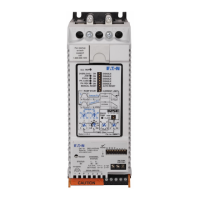Functional Description
S801+ Soft Starter MN03900002E—November 2012 www.eaton.com 23
Control Functions
Local Control
S801+ Local Control consists of Permissive, Start, Jog,
Disable Overload on Start and Reset 24 Vdc control
commands to the Terminal Block.
The Control Terminal Block utilizes five (5) functions to
control the S801+ soft starter.
Terminal P–Permissive (run enable)—Must be energized
with 24 Vdc to enable operation of the S801+ soft starters. If
power is lost or removed from Permissive terminal at any
time, the unit will initiate a coast Stop or Soft Stop in
accordance with the setup parameter selections.
Terminal 1–Start—If 24 Vdc is present at the Permissive
terminal, momentary application of 24 Vdc to the Start
terminal will initiate a Voltage Ramp or Current Limit start for
the S801+ soft starter. Application of 24 Vdc may be
maintained
Note: With level sensing control, if 24 Vdc is lost or removed
from the Permissive terminal at any time, the unit will
initiate a stop in accordance with setup parameter
selections. A restart may occur when 24 Vdc is
restored or reapplied if:
a) 24 Vdc is present on the Start terminal
(maintained), and;
b) the S801+ shows a Ready LED (not faulted) status.
If the starter has faulted and the fault condition
clears AND the Auto Reset Mode parameter in the
Operation Mode list is set to AUTO, the starter will
restart.
See the Edge and Level Sensing sections on Page 23
for additional details.
If the AUTO Reset Mode setting is used with level
sensing, CAUTION must be exercised to assure
that any restart occurs in a safe manner. Motor
restart may occur immediately and unexpectedly
after any fault condition has cleared.
Terminal 2–Jog—Application of 24 Vdc power to the Jog
terminal will initial a momentary Start command for as long
as the signal is present. The S801+ will perform a Start ramp
in accordance with Start parameters. If the motor achieves
synchronous speed, the internal bypass contactors will not
close. When the 24 Vdc signal is removed, the soft starter
will perform a coast stop, irrespective of any Soft Stop
parameter values.
Terminal 3–Overload on Start—Momentary application of
+24 Vdc to Terminal 3 prior to a start raises the overload fault
trip point to 125% of the maximum rating of the frame size
for the next start only.
Terminal 4–Reset—Application of 24 Vdc power to the
Reset terminal will reset the soft starter after all fault
conditions are cleared and no active fault is present. If the
Fault LED is not able to be reset, a fault condition still exists
and must be corrected.
Level or Edge Sensing
Level or Edge Sensing determines how the soft starter
reacts to Start control commands after a fault trip has
occurred. It is important to be aware if the Start command is
a momentary or maintained signal. If the Start contro
l signal
is momentary, then either Edge or Level Sensing may be
selected and S801+ operation will be the same, as in either
case only a momentary signal is placed on the Start terminal.
If the Start control signal is maintained, then the signal must
be removed, then reapplied to initiate a start if Edge Sensing
is selected.
Level or Edge Sensing is selected with the S1 DIP switch
located on the face of the S801+.
Level Sensing
Level sense means that the 24 Vdc signal at the Start
terminal may be continuous and does not require voltage to
be removed and reapplied after a fault trip has occurred.
Level sensing will result in an automatic motor restart after a
fault when:
●
Fault condition is cleared.
●
The Permissive terminal is supplied with 24 Vdc.
●
The Reset Mode parameter is set to AUTO,
●
There is 24 Vdc power to the Start terminal (Start
command—maintained).
Level sensing will allow a motor restart after a fault when:
●
All faults remain cleared or reset.
●
The Permissive terminal is supplied with 24 Vdc.
●
The Reset Mode parameter is set to AUTO or MANUAL.
●
24 Vdc power to the Start terminal is again applied (Start
command—momentary)
This control configuration can be used where it is desirable to
restart a motor after a fault without additional manual or
automatic control. An example of this condition would be on
a remote pumping station where it is desirable to
automatically restart a pump after a power outage without
operator intervention.
In the AUTO RESET MODE, CAUTION must be exercised
to assure that any restart occurs in a safe manner.

